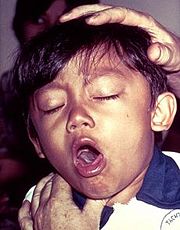Pertussis Toxin-ATP Complex
From Proteopedia
(Difference between revisions)
| Line 6: | Line 6: | ||
==structure== | ==structure== | ||
| - | The [http://en.wikipedia.org/wiki/Pertussis_toxin pertussis toxin] has been characterized as being an AB toxin meaning that there are 2 subunits: A subunit possesses the enzyme activity and the B possesses it the receptor binding portion. PT in particular is an AB5 toxin consisting of a six-component protein complex. With that in mind, this protein is a hexamer containing a catalytic (S1) subunit that is tightly associated with the pentameric cell-binding component (B-oligomer). The S1 component is a single subunit <scene name='Pertussis_Toxin-ATP_Complex/Subunit_1/3'>S1 (chains A,G)</scene> while the B-oligomer is a pentamer composed of four types of subunits: <scene name='Pertussis_Toxin-ATP_Complex/Subunit_2/3'>S2 (chains B,H)</scene>, | + | The [http://en.wikipedia.org/wiki/Pertussis_toxin pertussis toxin] has been characterized as being an AB toxin meaning that there are 2 subunits: A subunit possesses the enzyme activity and the B possesses it the receptor binding portion. PT in particular is an AB5 toxin consisting of a six-component protein complex, and the multiple subunits of the complex are not identical in composition. With that in mind, this protein is a hexamer containing a catalytic (S1) subunit that is tightly associated with the pentameric cell-binding component (B-oligomer). The S1 component is a single subunit <scene name='Pertussis_Toxin-ATP_Complex/Subunit_1/3'>S1 (chains A,G)</scene> while the B-oligomer is a pentamer composed of four types of subunits: <scene name='Pertussis_Toxin-ATP_Complex/Subunit_2/3'>S2 (chains B,H)</scene>, |
<scene name='Pertussis_Toxin-ATP_Complex/Subunit_3/5'>S3 (chains C,I)</scene>, two copies of <scene name='Pertussis_Toxin-ATP_Complex/Subunit_4/3'>S4 (chains D,E,J,K)</scene>, and <scene name='Pertussis_Toxin-ATP_Complex/Subunit_5/4'>S5 (chains F,L)</scene>.<ref name=Hazes>PMID: 8637000</ref> These subunits are encoded by a ptx genes, which are encoded on a large PT [http://en.wikipedia.org/wiki/Operon operon] that includes additional genes as well such as Pti genes. Together the PT and Pti proteins form the PT secretion complex. | <scene name='Pertussis_Toxin-ATP_Complex/Subunit_3/5'>S3 (chains C,I)</scene>, two copies of <scene name='Pertussis_Toxin-ATP_Complex/Subunit_4/3'>S4 (chains D,E,J,K)</scene>, and <scene name='Pertussis_Toxin-ATP_Complex/Subunit_5/4'>S5 (chains F,L)</scene>.<ref name=Hazes>PMID: 8637000</ref> These subunits are encoded by a ptx genes, which are encoded on a large PT [http://en.wikipedia.org/wiki/Operon operon] that includes additional genes as well such as Pti genes. Together the PT and Pti proteins form the PT secretion complex. | ||
Revision as of 04:01, 12 November 2011
| |||||||||||
References
- ↑ 1.0 1.1 Hazes B, Boodhoo A, Cockle SA, Read RJ. Crystal structure of the pertussis toxin-ATP complex: a molecular sensor. J Mol Biol. 1996 May 17;258(4):661-71. PMID:8637000 doi:10.1006/jmbi.1996.0277
- ↑ Carbonetti NH. Immunomodulation in the pathogenesis of Bordetella pertussis infection and disease. Curr Opin Pharmacol. 2007 Jun;7(3):272-8. Epub 2007 Apr 5. PMID:17418639 doi:10.1016/j.coph.2006.12.004
- ↑ Bettiol S, Thompson MJ, Roberts NW, Perera R, Heneghan CJ, Harnden A. Symptomatic treatment of the cough in whooping cough. Cochrane Database Syst Rev. 2010 Jan 20;(1):CD003257. PMID:20091541 doi:10.1002/14651858.CD003257.pub3

